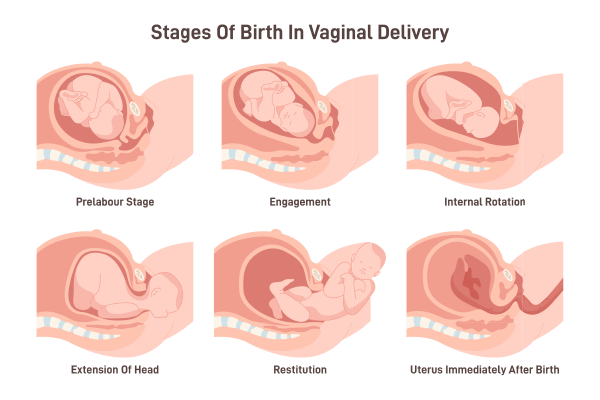
Preparing for normal delivery can be both an exciting and nerve-wracking experience. Understanding what to expect can help ease some of the anxiety and make the process smoother. Here's a comprehensive guide to help you prepare for a normal delivery:
Synopsis
Understanding Normal Delivery
A normal delivery, also known as a vaginal delivery, is the natural process of giving birth through the birth canal. It involves three stages: labour, delivery of the baby, and delivery of the placenta. Each stage has its own set of expectations and preparations.

Pregnancy tips for normal delivery - Prenatal Care
-
Regular Check-ups: Regular prenatal visits to your healthcare provider are crucial. These visits help monitor the health of both the mother and the baby. Your doctor will check your blood pressure, weight, and the baby’s growth and position.
-
Healthy Diet: Maintaining a nutritious diet that includes a variety of vitamins, minerals, and proteins is crucial for your health. Foods like leafy greens, fruits, lean meats, and whole grains provide the necessary nutrients for a healthy pregnancy.
-
Exercise: Engaging in regular exercise can enhance muscle strength and boost stamina, both of which are advantageous during labour. Consider the optimal benefits of activities such as walking, swimming, and prenatal yoga.
-
Education: Attending childbirth education classes can provide valuable information about the labour process, pain management techniques, and postpartum care. These classes also offer a chance to ask questions and address any concerns.
Also read: 10 Benefits Of Normal Delivery
Diet and Lifestyle Recommendations Before Delivery
|
Category |
Recommendations |
|
Foods for Energy and Strength |
- Complex Carbohydrates: Whole grains, brown rice, oats |
|
Hydration |
- Drink plenty of water throughout the day |
|
Light Physical Activity |
- Engage in gentle exercises like walking, prenatal yoga, and swimming |
Normal delivery procedure step by step:
Preparing for Labor
-
Birth Plan: Creating a birth plan can help you communicate your preferences to your healthcare team. This plan can include your preferred pain relief methods, who you want present during delivery, and any specific requests for the labor and delivery process.
-
Packing Your Hospital Bag: Pack a bag with essentials for both you and your baby. Include items like comfortable clothing, toiletries, important documents, baby clothes, and any personal items that will make your stay more comfortable.
-
Understanding Labor Signs: Familiarize yourself with the signs of labor, such as regular contractions, water breaking, and lower back pain. Knowing these signs can help you determine when it’s time to go to the hospital.
-
Pain Management: Explore different pain management options, including natural methods like breathing exercises, meditation, and massage, as well as medical options like epidurals. Discuss these options with your healthcare provider to decide what’s best for you.
The Stages of Labor
-
Early Labor: Early labour can extend over several hours or even days, with mild and irregular contractions. This period is ideal for resting, eating light meals, and staying hydrated. Practising relaxation techniques can also help you remain calm and comfortable.
-
Active Labor: Contractions become stronger, more regular, and closer together. It’s time to head to the hospital or birthing centre. Your healthcare provider will monitor your progress and the baby’s well-being.
-
Transition: This is the most intense part of labour, but it’s also the shortest. Contractions are very strong and close together. You may feel pressure in your lower back and pelvis. Focus on your breathing and rely on your support team for encouragement.
-
Emotional Changes: Hormonal shifts can cause mood swings, anxiety, and depression. Recognizing these changes as normal helps in managing them.
Delivery
-
Pushing: Once your cervix is fully dilated, you’ll start pushing. This stage can last from a few minutes to a few hours. Listen to your body and your healthcare provider’s instructions. Use different positions to find what’s most comfortable for you.
-
Birth of the Baby: As the baby’s head crowns, you may feel a burning or stretching sensation. With a few more pushes, your baby will be born. Your healthcare provider will place the baby on your chest for immediate skin-to-skin contact, which is beneficial for both you and the baby.
Post-Delivery

-
Delivery of the Placenta: After the baby is born, you’ll need to deliver the placenta. This usually happens within 30 minutes. Your healthcare provider may massage your abdomen to help the placenta detach and be expelled.
-
Recovery: After delivery, you’ll be monitored for a few hours to ensure there are no complications. You may experience some bleeding and cramping as your uterus contracts back to its normal size. Rest, hydration, and proper nutrition are important during this time.
-
Breastfeeding: If you choose to breastfeed, try to start as soon as possible after birth. Breastfeeding has many benefits for both the mother and the baby. Lactation consultants can provide support and guidance if needed.
Emotional and Mental Preparation
-
Support System: Surround yourself with supportive people, whether it’s your partner, family, or friends. Having a strong support system can provide emotional comfort and practical help.
-
Managing Expectations: Understand that every labour and delivery experience is unique. It’s important to be flexible and open to changes in your birth plan if necessary.
-
Self-Care: Dedicate time to unwind and alleviate stress. Engaging in activities such as reading, enjoying a warm bath, or practising mindfulness can help you maintain calmness and focus.
Common Concerns and Questions
-
Pain During Labor: It’s natural to be concerned about pain during labour. Remember that there are many pain relief options available, and your healthcare provider will help you manage the pain effectively.
-
Complications: While most deliveries go smoothly, it’s important to be aware of potential complications like prolonged labour, fetal distress, or the need for a cesarean section. Your healthcare team is trained to handle these situations and ensure the best outcome for you and your baby.
-
Postpartum Recovery: Recovery after a normal delivery varies for each woman. It’s normal to feel tired and sore. Follow your healthcare provider’s advice on postpartum care, and don’t hesitate to ask for help if you need it.
Fresh Perspectives
-
Alternative Therapies During Labor: Consider alternative therapies such as acupuncture, aromatherapy, and hypnobirthing to complement traditional pain relief options.
-
Cultural Practices Around Normal Delivery: Childbirth practices vary across cultures, including the role of traditional birth attendants and postpartum customs. Understanding these practices can enhance the childbirth experience and provide culturally sensitive care.
Final Thoughts
Preparing for a normal delivery involves physical, emotional, and mental preparation. By staying informed, maintaining a healthy lifestyle, and having a strong support system, you can approach labour and delivery with confidence. Remember that it’s okay to ask for help and to be flexible with your birth plan. Every birth experience is unique, and the most important thing is your and your baby's health and well-being.
For those in the Ghaziabad area, Manipal Hospital Ghaziabad offers exceptional prenatal and delivery care. With a team of experienced Obstetrics and Gynaecology experts in Ghaziabad and state-of-the-art facilities, Manipal Hospital ensures that you and your baby receive the best possible care throughout your pregnancy and delivery journey. Their comprehensive services and compassionate approach make them a trusted choice for expecting parents.
FAQ's
Labour signs include regular contractions, water breaking, lower back pain, and a bloody show (mucus plug discharge). If you experience any of these signs, contact your healthcare provider immediately.
Postpartum recovery involves rest, hydration, and proper nutrition. You may experience bleeding and cramping as your uterus contracts back to its normal size. Follow your healthcare provider’s advice on postpartum care.
Surround yourself with supportive people, manage your expectations, and practice self-care activities like reading, taking warm baths, or mindfulness exercises. Childbirth education classes can also help you feel more prepared.
Different positions like squatting, kneeling, sitting, or lying on your side can help during labour and delivery. Changing positions can ease discomfort and help the baby move down the birth canal more effectively.



















 7 Min Read
7 Min Read














